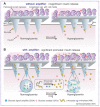Progress in Microneedle-Mediated Protein Delivery
- PMID: 32079212
- PMCID: PMC7073601
- DOI: 10.3390/jcm9020542
Progress in Microneedle-Mediated Protein Delivery
Abstract
The growing demand for patient-compliance therapies in recent years has led to the development of transdermal drug delivery, which possesses several advantages compared with conventional methods. Delivering protein through the skin by transdermal patches is extremely difficult due to the presence of the stratum corneum which restricts the application to lipophilic drugs with relatively low molecular weight. To overcome these limitations, microneedle (MN) patches, consisting of micro/miniature-sized needles, are a promising tool to perforate the stratum corneum and to release drugs and proteins into the dermis following a non-invasive route. This review investigates the fabrication methods, protein delivery, and translational considerations for the industrial scaling-up of polymeric MNs for dermal protein delivery.
Keywords: antigen delivery; drug delivery; microneedles; protein; transdermal.
Conflict of interest statement
The authors declare no conflict of interest.
Figures








References
-
- Rawat A., Burgess D.J. Parenteral Delivery of Peptides and Proteins, in Biodrug Delivery Systems. CRC Press; Boca Raton, FL, USA: 2016. pp. 66–84.
Publication types
LinkOut - more resources
Full Text Sources

